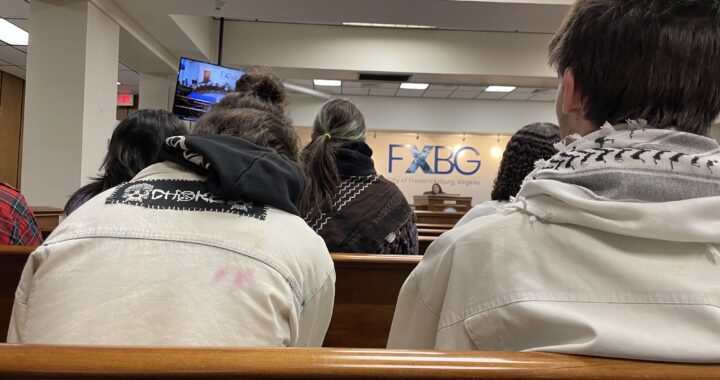Students dazzle at Senior Art Show
6 min readBy LAUREN JURGENSEN
Staff Writer
February 16th’s grand opening of “Cynosure,” the Senior Art Exhibition, came to a standstill when one artist switched off the lights and surprised the guests with an unexpected performance.
Standing before a wall that featured both a map of the world and projected images of varying shapes and textures, senior Sarah Perry began reciting entries from a personal journal she kept while traveling through Europe last summer.
After each recitation, Perry tore out a page and nailed it to the wall with a hammer she kept in her pocket. The hammer was connected to a ribbon in Perry’s hair, from which also hung a pair of scissors. Perry had tangled pieces of her own hair into the scissors, the hammer and the nails.
“The piece was about having control,” Perry said. “I had only written about things that upset me, that made me feel vulnerable and helpless. And that was the way I could deal with them. I wrote them down and it was like they didn’t exist anymore. So reading these entries was extremely tough for me.”
Perry she calls the piece “Recontres,” a French word that has no exact English translation but can be understood roughly as a noun meaning, “people that you meet.” “The journal entries were all about the men that I met along my journeys,” she said. Perry’s performance lasted for about ten minutes, after which she left the room. Other works by Perry featured at the “Cynosure” exhibit demonstrate her commitment to theatrics and performance art. Included are photographs and remnants from two dinners she held at the “The Wounded Bookshop” in downtown Fredericksburg.
Both dinners were themed by color (“The Golden Hue Dinner” and “The Scarlet Hue Dinner”) and required guests to wear certain art objects and act in accordance with specific characterizations that they had either chosen or been given. Perry’s collection also included her work “Stilted Modesty,” a gown made entirely of pantyhose and metal, which won her first prize at the Wearable Art contest in November at The 1708 Gallery in Richmond. Cynosure includes work from nine other senior art majors, among them Adrian Loving, Annice Mulhare, Beth Jordan, Greta Schorn, Jennifer Stewart, Krystal Postupack-Davies, Lindsey Victoria, Thomas Wilson and Natalie Be’er.
Be’er presented several photographs she had taken while studying abroad in Israel. The collection consisted almost entirely of portraits taken of the people she met along the way.
“The ones with their faces toward the camera I spoke to,” she said. “People treat you differently when you’re carrying around a camera.” Be’er added that the three young men portrayed in one of her photographs had followed her around until she finally gave in and took their picture.
“When people see Israel in the news, it’s all negative, all war, all militaristic. I wanted to show that it’s a city like every other city,” Be’er said.
Across the gallery from Be’er’s photographs is the digital work of Mulhare. Her work,“Digital Transitions” uses a video-like medium to revolve through the several layers involved in the creation of one of her images. “It was really exciting, because I got to present my digital art in a very digital way,” Mulhare said. “People can see how I put it together.” Postupack-Davies’ collection was also focused on details. In one work entitled “Creep,” she pushed 2,000 pins into a sheet of mylar to form a painstaking design. “It was pretty labor intensive,” she said.
Wilson’s collection, like Be’er’s, includes photographs from his time studying abroad last spring. Called “Prague, Easter Morning,” the four-color photographs document Wilson’s visit to the Charles Bridge in Prague. Wilson also showcased two stoneware creations, as well as an oil painting entitled, “Bea,” which is a portrait of a maid who worked across the street from his home. “I based the painting off of a photograph, but there are degrees of separation between the painting and the photo,” he said.
Wilson placed his hand over one side of painting and said, “If you look at it this way, with the right eye covered ere, she seems to be sad, but if you move your hand over the other eye she appears angry. That’s something I noticed about it.” In an oil painting called “Pondera et Hominis,” which is Latin for “Equilibrium of Man,” Loving shows the relationship between three distinct figures, one of which can be described as god-like. Loving said he was inspired by the styles of the Renaissance during its creation. “I am trying to show the relationship of good and evil in terms of religion,” he said. “The painting represents a scale, but is also arranged to look like a cross. I wanted something that showed a level of skill.”
To the left of Loving’s painting is Schorn’s “Michael Can Write,” an etching she created of words written by her brother Michael on a sheet of notebook paper. Schorn said that Michael, who is in special education, has, “a language that means something to him, but we cannot understand it.”
In a corner at the other end of the wall is a sculpture by Stewart. “Reflections,” was created by bending and painting a sheet of screen to appear like a person’s backside. A piece of black silk was hung from the screen, providing the illusion of a shadow. On the wall is a painting of a face that can be interpreted as the reflection of the person depicted by the sculpture.
In Jordan’s collection of stoneware, she placed pottery in an unusual context by arranging several warped, distorted bowls diagonally across a wall. “They were thrown like normal, round bowls, but I altered them,” she said. This same attention to the artistic effect of alteration could be found in the work of Victoria. In two of her works, “Stonington” and “The Point Isn’t Perfection,” Victoria merged two separate paintings by cutting one vertically and the other horizontally, then weaving them together to create a totally new image. “I based both off of photographs I took of my hometown in Connecticut,” said Victoria.
For these senior art majors, the Art Exhibition is more than an opportunity to display their artwork. It is also their version of a senior thesis. “About one year before their graduation, students must decide whether to have a senior exhibition or an exit portfolio,” said Dr. Carole Garmon, assistant professor of art. “Most of our majors opt for the senior exhibition… while it is a lot of work the experience is rewarding. It is a collaborative effort where all students are expected to give 100%, [and it] provides our majors with the opportunity to experience all aspects of professional exhibition in a safer environment.”
Robert Lynn, junior art major and assistant at the DuPont Gallery, played a major role in the collaborative effort described by Dr. Garmon. “My job has been to act as the go-between between the seniors and the gallery,” said Lynn. Lynn and sophomore Andrew Sniffin managed the entire installation of the exhibit. “Cynosure,” is defined as “Anything to which attention is strongly turned; a center of attraction” Through their work, the seniors and the gallery managers believe they have created what can rightly be called a “center of attraction.” “Cynosure” is the first of two Senior Art Exhibitions this semester, and runs to the 25th of February. The next Senior Art Exhibition opens on March 16th.











